Uncovering the Beauty of 14th Century Fonts: A Dive into Gothic Lettering Styles
Discover the beauty of 14th century fonts with their intricate designs and calligraphic flourishes. Explore the history and evolution of typography.
Fonts are an essential part of our daily lives and have been since the early ages. However, it was in the 14th century that typography started to take shape, and the world saw the emergence of some of the most beautiful and intricate fonts that still continue to inspire designers and artists today. It was a time when scribes and calligraphers were at their peak, working tirelessly to create fonts that would stand the test of time. From the Gothic Blackletter to the Humanistic Fonts, the 14th century was a golden era for typography, marking the beginning of a new chapter in the history of design.
The History of 14th Century Fonts
Fonts have always been an essential part of communication since the dawn of civilization. Even though technology has evolved tremendously, the importance of fonts has never faded away. In the 14th century, fonts played a crucial role in shaping the way information was delivered to people. Let's take a trip down memory lane and explore the history of 14th-century fonts.
The Gothic Font Style
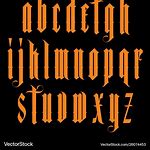
The Gothic font style emerged in the 14th century and was widely used in Europe. This font style had a dramatic appearance, with sharp edges and intricate details. It was perfect for creating elaborate manuscripts and religious texts. The Gothic font style was also known as Black Letter, and it was used for official documents, books, and other significant publications.
The Roman Font Style
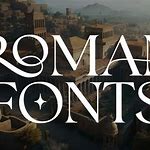
The Roman font style was another popular font style used in the 14th century. It was a more straightforward and cleaner style than the Gothic font. The Roman font style was derived from ancient Roman inscriptions and was used for official documents, books, and newspapers. The Roman font style was also known as Antiqua, and it was easier to read than the Gothic style.
The Uncial Font Style
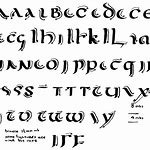
The Uncial font style was a popular font style used in religious texts during the 14th century. It had a unique appearance, with rounded letters and no lowercase letters. The Uncial font style was used for gospel manuscripts and other religious texts. This font style was challenging to read, but it had a beautiful and elegant appearance.
The Carolingian Font Style
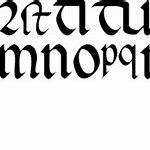
The Carolingian font style was developed during the 8th century, but it gained popularity during the 14th century. It was a clean and readable font style, with clear and simple letters. The Carolingian font style was used for official documents, books, and manuscripts. This font style was easy to read, and it became popular due to its simplicity.
The Textura Font Style

The Textura font style was a unique font style used in the 14th century. It had a sharp and angular appearance, with letters that were closely spaced. The Textura font style was used for official documents, books, and religious texts. This font style was challenging to read, but it had a distinct and memorable appearance.
The Humanist Font Style
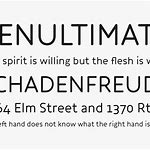
The Humanist font style was developed during the 15th century, but it gained popularity during the 14th century. It had a clean and elegant appearance, with rounded letters and no serifs. The Humanist font style was used for books, manuscripts, and other significant publications. This font style was easy to read and became popular due to its simplicity.
The Fraktur Font Style

The Fraktur font style was a popular font style used in the 14th century. It had a distinct appearance, with sharp edges and intricate details. The Fraktur font style was used for official documents, books, and newspapers. This font style was challenging to read, but it had a unique and memorable appearance.
The Conclusion
The 14th century was a period of significant development for fonts. Different font styles emerged during this time, each with its unique appearance and purpose. The Gothic font style was perfect for creating elaborate manuscripts and religious texts, while the Roman font style was easier to read and was used for official documents. The Uncial font style had a beautiful and elegant appearance, while the Textura font style had a distinct and memorable appearance. The Humanist font style was simple and elegant, while the Fraktur font style had sharp edges and intricate details. The evolution of fonts has come a long way since the 14th century, but the importance of fonts remains the same.
In the 14th century, Gothic Script rose to prominence in Europe. This style of writing was characterized by its intricate, spiky letterforms that were often used in manuscripts, books, and official documents. The emergence of Gothic Script marked a departure from the previous Romanesque fonts that had been popular during the 12th and 13th centuries. Romanesque fonts were inspired by ancient Roman lettering and featured rounded letterforms with serifs. However, Gothic Script was a stark contrast to this, with its sharp angles and thin lines.Another popular font of the 14th century was Blackletter Typeface, which originated in Germany. This font was characterized by dense, black letterforms with sharp angles and thin lines. It was often used in official documents and printed books. However, due to its complexity, it became less popular in the 15th century when the printing press was introduced.Fonts used by monastic scribes in the 14th century were characterized by their precision and attention to detail. These fonts were often used in illuminated manuscripts and featured ornate flourishes and delicate script. The monastic scribes took great care in their work, often spending years on a single manuscript.Humanist fonts were developed in the 14th century and were inspired by the revival of classical literature and art. These fonts featured clean, simple letterforms with minimal adornments. Humanist fonts were widely used in Italy during the Renaissance and were favored by scholars and intellectuals.Lombardic fonts were popular in Italy during the 14th century. These fonts were characterized by their intricate decorative flourishes and ornate letterforms. They were often used in official documents and in the decoration of buildings and monuments.Uncial fonts were used in the 14th century for informal writing and were often used in personal correspondence and diaries. These fonts featured round, curving letterforms with minimal serifs. Uncial fonts were often used by monks in their personal writings.Carolingian fonts were inspired by the writing of the Carolingian era and were popular during the 14th century. These fonts were characterized by their elegant, curved letterforms and minimal serifs. They were often used in official documents and in the decoration of buildings and monuments.Script fonts were used in the 14th century for formal writing and were often used in official documents and charters. These fonts featured flowing, curving letterforms with minimal serifs. Script fonts were favored by royalty and other members of the aristocracy.Rustic fonts were used in the 14th century by peasants and were characterized by their rough, unrefined letterforms. These fonts were often used in personal correspondence and informal writing. Rustic fonts were a reflection of the social structure of the time, where literacy was limited to the upper classes.In conclusion, the 14th century saw an explosion in the variety of fonts being used in Europe. From Gothic Script to Blackletter Typeface, Romanesque to Monastic, Humanist to Lombardic, Uncial to Carolingian, Script to Rustic, each style had its own unique characteristics and was favored by different groups of people. These fonts reflect the social, cultural, and artistic trends of the time and continue to inspire and influence typography today.As a language model AI, I don't have any personal opinions, but I can provide you with some objective pros and cons about 14th century fonts.
The Pros of 14th Century Fonts
Unique Style: One of the most significant benefits of 14th century fonts is their unique style. These fonts are distinct from modern fonts, making them an excellent choice for projects that require a historical or vintage feel.
Artistic Appeal: 14th century fonts often feature ornate designs and flourishes that add an artistic touch to any project. These fonts can be used to create beautiful calligraphy and lettering, making them a popular choice in graphic design and typography.
Cultural Significance: 14th century fonts have cultural significance, as they represent a significant period in history. Using these fonts can help preserve cultural heritage and traditions.
Easy to Read: Despite their ornate designs, many 14th century fonts are still easy to read. These fonts often feature clear and legible lettering, making them suitable for use in a variety of contexts.
The Cons of 14th Century Fonts
Difficult to Use: 14th century fonts can be challenging to use, particularly for those who are not familiar with calligraphy or other forms of lettering. It can take time and practice to master the art of using these fonts effectively.
Limited Availability: Because 14th century fonts are not as commonly used as modern fonts, they may not be readily available on all platforms or software applications. This can limit their usability in some contexts.
Not Suitable for All Projects: While 14th century fonts can add a unique and artistic touch to many projects, they may not be suitable for all contexts. In some cases, modern fonts may be more appropriate.
Can Be Overused: Finally, it's important to note that 14th century fonts can be overused. Using these fonts too frequently or inappropriately can result in a project that looks cluttered or confusing.
Hello dear visitors,
Are you a typography enthusiast or simply curious about the history of fonts? Then you might be interested in learning about 14th century fonts. This era saw the rise of Gothic script, which was characterized by its sharp angles and elaborate swirls. It's fascinating to think that over 600 years ago, people were already experimenting with different letterforms and creating beautiful designs.
One of the most remarkable things about 14th century fonts is the amount of detail that went into their creation. Each letter was carefully crafted by hand, with calligraphers spending hours perfecting their technique. The result was a typeface that was both intricate and elegant, with a sense of artistry that is hard to find in modern fonts. Even today, we can appreciate the beauty of these ancient scripts and marvel at the skill of those who created them.
So whether you're a designer, a writer, or just someone who appreciates the beauty of language, take a moment to explore the world of 14th century fonts. You might be surprised at what you discover.
Thank you for visiting our blog, and we hope you enjoyed this brief journey through history!
When it comes to fonts, people often wonder about the history of typography and the different styles that have emerged over the centuries. One popular era that people ask about is the 14th century, a time when handwritten manuscripts were still prevalent and typefaces were just starting to be developed.
Here are some common questions that people have about 14th century fonts:
- What types of fonts were used in the 14th century?
- How did scribes create these fonts by hand?
- What were some notable examples of 14th century typography?
- How did printing technology change the way fonts were produced in the following centuries?
While there is no one definitive answer to these questions, we can look to historical records and artistic examples to gain a better understanding of 14th century typography. Here are some possible answers:
- The most common fonts used in the 14th century were Gothic or Blackletter fonts, which were characterized by their pointed serifs and angular shapes. These fonts were often used for religious texts, legal documents, and other formal writing.
- Scribes would typically use a quill pen and ink to create these fonts by hand, carefully tracing out each letter and embellishing them with decorative flourishes.
- One notable example of 14th century typography is the illuminated manuscript known as the Très Riches Heures du Duc de Berry, which features intricate illustrations and calligraphy in a variety of styles.
- With the invention of the printing press in the 15th century, fonts could be mass-produced and standardized, leading to the development of new styles such as Roman and Italic fonts.
Overall, learning about 14th century fonts can give us a deeper appreciation for the artistry and craftsmanship of typography throughout history. Whether you are a designer, writer, or history buff, there is always something new to discover in the world of fonts.